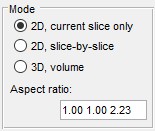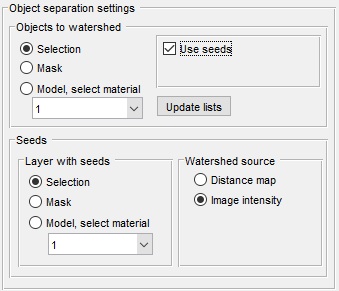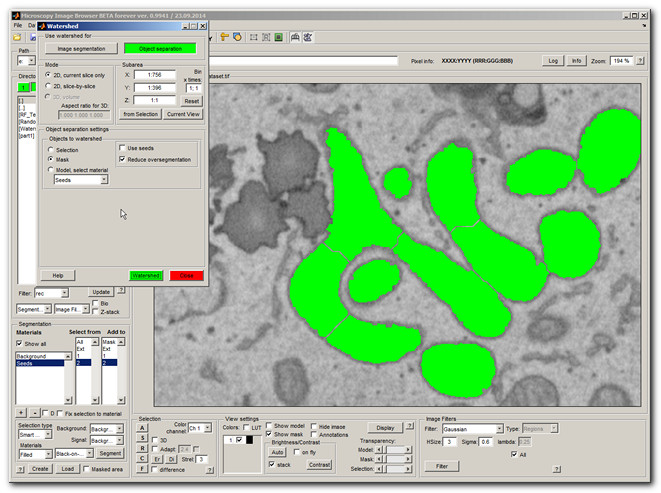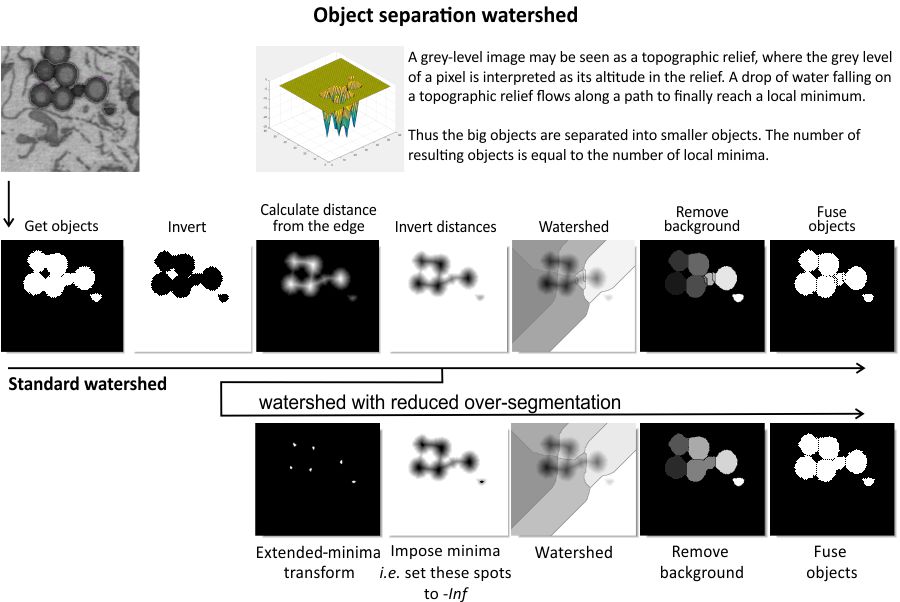Object Separation with Watershed
Tools for separating objects that can be stored as materials in the current model, the mask layer, or the selection layer.
Back to MIB | User interface | Menu | Tools
Overview
The Object separation tool in Microscopy Image Browser (MIB) utilizes watershed and graphcut segmentation techniques to divide connected objects into smaller, distinct entities. These objects can originate from the Selection, Mask, or Model layers, making this tool versatile for refining segmentation results.
Mode panel
The Mode panel allows you to choose the segmentation scope, determining whether the operation applies to a single slice, multiple slices, or the entire volume.

- performs segmentation only on the currently displayed slice in the Image View panel
- applies 2D segmentation individually to each slice in the dataset
- executes 3D segmentation across the entire dataset or a selected subvolume (see Subarea panel below)
- displays the dataset's aspect ratio, calculated from voxel sizes found in Menu → Dataset → Parameters. this ratio is used when watershed segmentation relies on a distance map (see Object separation settings below)
Subarea panel
The Subarea panel enables you to define a specific portion of the dataset for processing. this is particularly useful for large datasets that need to be segmented in parts or reduced in resolution.

- : specifies the width range of the dataset to process, using two numbers separated by a colon (e.g.,
1:512) - : defines the height range of the dataset to process
- : sets the z-slice range of the dataset to process
- : populates the X, Y, and Z fields with coordinates from a bounding box around the Selection layer
- : restricts the X and Y ranges to the currently visible area in the Image View panel
- : restores the subarea fields to the full dimensions of the dataset
- : applies a binning factor to downsample the data before segmentation, speeding up the process at the cost of detail.
Warning
binning in Object separation mode may lead to unpredictable results
Object separation settings
The Object separation mode employs watershed transformation to split segmented objects into smaller units. below are the specific settings for this mode.
- Object to watershed: selects the source layer containing the object to be separated, choosing from Selection, Mask, or Model
- activates the seeded watershed transformation, requiring additional settings in the Seeds panel below
- Reduce oversegmentation: (available only for unseeded watershed) reduces the number of resulting objects, helping to prevent excessive fragmentation
- Seeds panel: (active only when is checked)
- Layer with seeds: specifies the layer containing seed points, selectable from Selection, Mask, or Model
- Watershed source: determines the data used for watershed labeling
- Image intensity: uses the actual image intensities instead of distance maps. for more details, see Steve Eddins's blog on cell segmentation
Object separation example
The Object separation mode with watershed can split large, fused objects into smaller, individual components. for instance, in a segmentation example featuring mitochondria, some appear merged. this tool can separate them effectively.
- Navigate to Menu → Tools → Object separation
- Select Mask in the Object to watershed dropdown
- Click the button
This separates the mitochondria, but unseeded watershed often oversegments, breaking long mitochondria into multiple small pieces. to address this, use the seeded watershed approach:
- Check
- In the Seeds panel, set Layer with seeds to Model and select the 'Seeds' material
- Click the button
- If each mitochondrion has a single seed label, individual mitochondria will be extracted (highlighted in green)
Algorithm for object separation with watershed
The diagram above illustrates the step-by-step process of the watershed-based object separation algorithm, showing how it transforms input data into separated objects.
References
For further reading on watershed segmentation in both image segmentation and object separation modes:
- Watershed transform question from tech support by Steve Eddins
- Cell segmentation by Steve Eddins
Back to MIB | User interface | Menu | Tools




